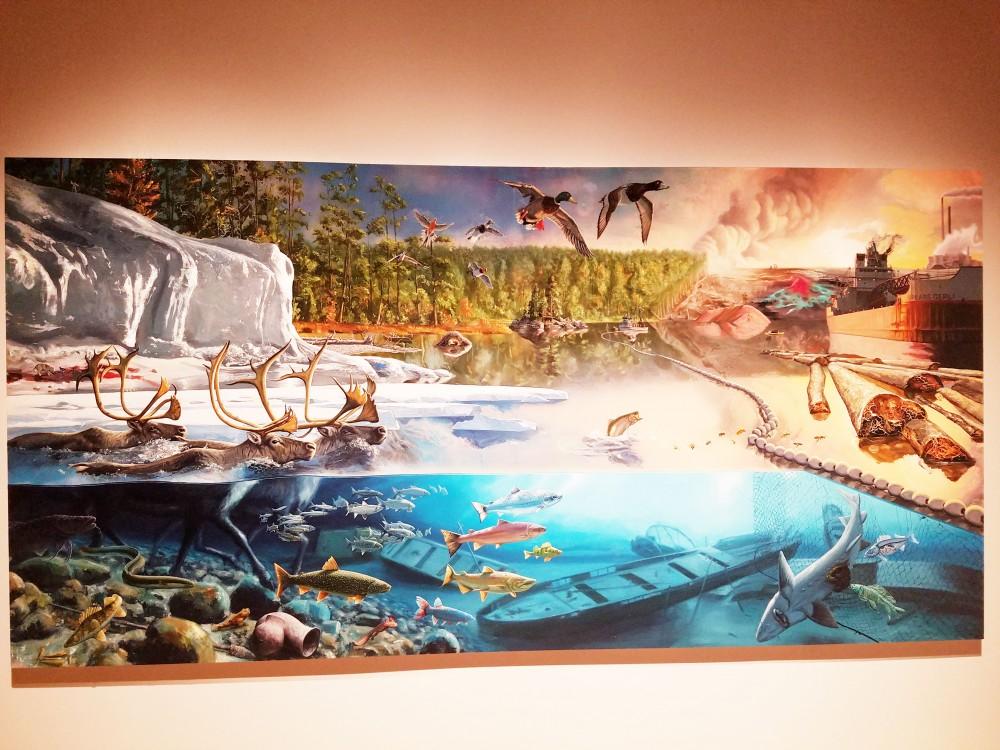New York artist’s Great Lakes paintings on display at Grand Rapids Art Museum

GVL / Anne Marie Smit
Jan 29, 2018
The Great Lakes, which constitute the largest body of fresh water in the world, are one aspect of the Michigan environment that makes it unique. Alexis Rockman, an artist from New York, has visited the Great Lakes and studied them over a number of years, producing paintings he hopes will initiate discussion on the importance of the Great Lakes for many ecosystems, as well as how they are threatened by climate change, globalization, invasive species, mass agriculture and urban sprawl. Rockman’s project, “The Great Lakes Cycle,” will be on display at the Grand Rapids Art Museum (GRAM) until Sunday, April 29.
To gather research for his artwork, Rockman visited eight states, including some Canadian provinces. The exhibit includes all of Rockman’s recent work, including six watercolor paintings and five mural-sized paintings that chronicle how the Great Lakes have evolved throughout history, ranging from the Pleistocene Era to present day. A title and description of each painting is provided so that visitors understand Rockman’s intended message.
Rockman looks to the past for his paintings, but his work is futuristic: He imagines the impact of our current environmental decisions on the future of the Great Lakes.
When he encountered posters of Michigan, Rockman recognized that there was a side of Michigan’s story that wasn’t being represented, a much more bleak side, and he decided people needed to be informed about it.
“There’s a series of the state of Michigan posters that I see around—you know, like Sleeping Bear Dunes or White Pine Forest or a river,” Rockman said. “I would see these posters and I’d be like, ‘That’s only half the story. There’s a much darker story that’s happening in these images.’
“And that’s what I’m after: the story that only an artist can tell in this culture, or a novelist, because when you’re controlling your own production, and you don’t have corporate overlords to answer to, you can basically do whatever you want as long as you’re responsible.”
Rockman spoke about his painting “Forces of Change,” which takes a look at what caused the Great Lakes to change over the years.
“I started to look at a lot of images from the 20th century,” Rockman said. “There’s a wonderful image that describes the reach of standard oil in 1908 that shows an octopus in the middle of the U.S., and his tentacles go in every direction across the map. One of the things that we’re going to have to deal with is the idea of disease, and I decided that I was going to make a character that I call the ‘E. Coli Kraken’: … the idea of the enormity and the power of these things that are invisible.”
Dana Friis-Hansen, GRAM director and CEO, put the octopus metaphor in more recognizable terms, speaking about how the Great Lakes connect to other bodies of water.
“What that shows is that the Great Lakes, by extension of the Mississippi River, the Erie Canal, the Saint Lawrence Seaway, actually reaches almost every single ocean in the world,” Friis-Hansen said. “It’s part of this bigger system, and that’s why I think (‘Forces of Change’) is a fascinating painting. You’ve got the barrier of the Great Lakes, which protected this lake for centuries and centuries, and then humans (decided) that it’s a great idea to build a canal. They didn’t know about invasive species.”
While Rockman did create the paintings to educate people on how the Great Lakes are threatened, he said he’s less hopeful about it making a difference than he used to be. Americans don’t value art or discuss the meaning of it, he said, so it’s difficult to reach people through that medium.
“I think in America it’s a little challenging because people generally don’t know what art is in America,” Rockman said. “Unless they’re looking at auction prices, there’s really no meaning to it. (Dana) and I truly believe that education is our only hope, and that’s why we’re doing this, … but I’m not sure what to say about doing something over and over again and expecting different results.
“I’m less hopeful than I was 10 years ago, but I still get out of bed and do what I do.”
In addition to the paintings showcased, there will be a digital map displayed that allows visitors to see the places Rockman visited, as well as interactive spaces where people can put together puzzles of Rockman’s paintings and write on note cards what they plan to do to protect the Great Lakes.
Admission to the GRAM is $10 for adults and $8 for students with an ID, with free admission on Tuesdays from 9 a.m. to 5 p.m. and Thursdays from 5 p.m. to 9 p.m.
For more information on Rockman and listings of upcoming events related to the exhibition, visit www.artmuseumgr.org.

























